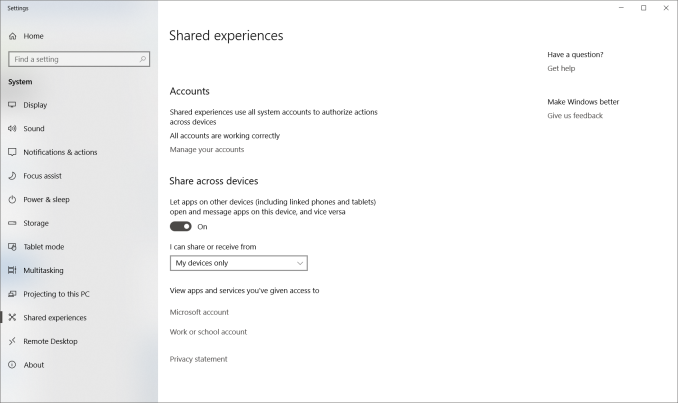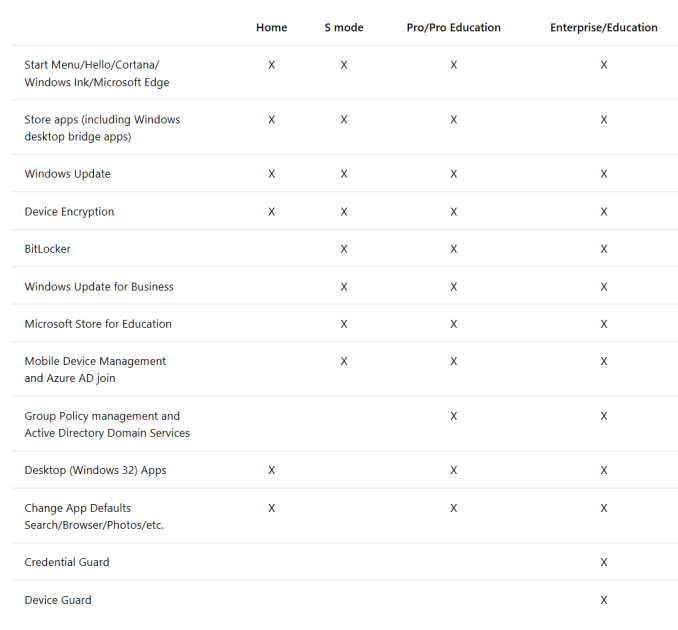The Windows 10 April Update (1803): The Littlest Big Update
by Brett Howse on May 25, 2018 8:00 AM EST- Posted in
- Software
- Operating Systems
- Windows
- Microsoft
- Windows 10
Nearby Share
One feature that should be very useful to certain people is Nearby Share. This lets you quickly and easily share files between people from PC to PC, without having to send an email or use a messaging app as the transfer tool. Nearby Share works over Bluetooth or Wi-Fi, and will use Wi-Fi as the preference. In an office, this was something done via a USB drive most recently, but with wireless and Bluetooth in all modern laptops, it makes sense to leverage that to avoid a step.
It should be very useful in certain situations, and isn’t tied to an account so you can send to any nearby device. The receiver will have the option of accepting the file. It’s not on by default, but can be toggled on when needed. It’s definitely something you’d not want to leave on.
Easy Bluetooth
Windows 10 now supports a simpler Bluetooth pairing process for some devices which lets you pair devices with a single click. You’ll get a pop-up notification asking if you want to pair a device, and if you say yes, it’s all setup. Devices have to support this though, and ones that require PINs are not going to work with a single click setup.
Windows 10 S Mode
Windows 10 S launched with the Surface Laptop as its first device to offer the constrained version of Windows 10 that restricts users to only running apps from the Store. The idea was to keep people from harming themselves, and to keep performance levels where they should be, by not allowing people to just install whatever they want, and to keep apps in packages that allow for easy removal and less items running at startup. This is pretty much how any modern smartphone works of course, but the downside to it on Windows 10 was that the Microsoft Store is not known as one of the key selling features, so uptake and usuage of Windows 10 S had to be pretty small. With the April Update, this is replaced by Windows 10 in S Mode, which is just a setting that can be enabled on any PC to make it like Window 10 S was. It'll still likely never get used, but it's a much better solution than another version of the OS just for this purpose. There's reasons you'd want this of course - education being a great example - but the average consumer is choosing Windows for the legacy application support, so this new model is definitely the better way to handle it.
The drawback is that S Mode is a one-way setting at the moment. A machine can be set in S mode when imaged using an unattended.xml file and dism, but if it's set back to regular Windows 10, there's not a way to switch back and forth.












161 Comments
View All Comments
0ldman79 - Friday, May 25, 2018 - link
Every major update has reset my 7.1 surround settings, the Nvidia settings and my firewall.Kind of irritating, spending time tuning the colors, fine tuning for the shape of the room, etc... only to have MS just wipe it out arbitrarily.
Stuka87 - Friday, May 25, 2018 - link
Why are earth are you using a RAID-0 as your boot drive?! Just about every SSD these days is faster than a RAID-0 spinner array. And doing a RAID-0 with SSDs is not recommended at all.DanNeely - Friday, May 25, 2018 - link
The same koolaid that gaming laptop makers - who love to raid0 multiple SSDs - are convinced their customers are guzzling.RAID0 doesn't help latency, and that's where 99% of the gain from HDD to SSD to Optane is to be found.
BurntMyBacon - Tuesday, May 29, 2018 - link
That ain't koolaid. Least not the kind what you find around here. Got a kinda funny aftertaste. Makes you feel all fuzzy in the head. Wake up the next morning wonderin how that laptop got there and what you were doin with it to get that black screen what never goes away on boot.euler007 - Friday, May 25, 2018 - link
Not only that but two Nvme drives in raid 0 as a boot drive. Zero real world gains except on static benchmark.Holliday75 - Friday, May 25, 2018 - link
The gain being you are twice as likely to lose a OS drive and need to reinstall all your software! Well a gain for people who like doing that.Makaveli - Friday, May 25, 2018 - link
Some people like myself combine SSD's in Raid 0 for more capacity than speed.still using two Intel X25-M G2 160GB in Raid 0
piiman - Saturday, May 26, 2018 - link
You don't get more capacity, its the same.MamiyaOtaru - Saturday, May 26, 2018 - link
wrong. Raid 1, where each drive is mirrored, would get you the same capacity. But two 160GB drives in raid 0 (striped) gives a capacity of 320."capacity of a RAID 0 volume ... is sum of the capacities of the disks in the set." https://en.wikipedia.org/wiki/RAID#Standard_levels
I love how sure you seem about this while being totally wrong haha
Alexvrb - Sunday, May 27, 2018 - link
Your total capacity is still the same, which is what he's saying. Drive 1+2 = RAID 0 array of drive 1+2. You just get them both on one drive letter, and at that point you could use JBOD. It's pointless to use RAID 0 and it increases the risk of data loss.Anyway those are some ancient SSDs. I remember reading about them... the Mayans, I believe?